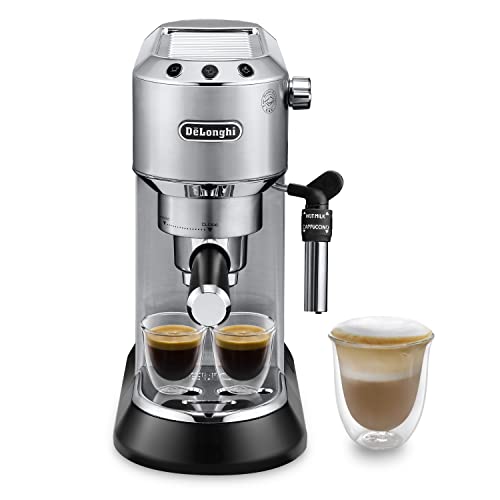What to Look For in a Commercial Espresso Machine
There are a myriad of things to take into consideration when buying a commercial espresso machine. Your cafe's volume, intended use for service, and barista's experience will determine which espresso machine is the best for your business.
Double boilers allow you to brew while steaming. This reduces the time required to recover between pulls. Proportional-integral-derivative (PID) temperature control manages on/off cycles for optimal boiler temperatures.

Productivity
A commercial espresso machine is designed to handle a much more volume of coffee than a home espresso machine. A home espresso machine will not be able to perform in a professional setting.
A commercial coffee machine of good quality can serve up to 100 coffee cups every hour during peak hours. This can be a great help in busy offices, as it stops workers from waiting to get their coffee.
A coffee machine can also help workers bond. In many cases, teams of workers make a habit of getting coffee for each other, and this can foster teamwork and collaboration in the workplace. A designated coffee area can make new employees feel more comfortable in their workplace and break down barriers between them, senior staff members, and other workers.
Commercial espresso machines are available in several sizes to meet a variety of requirements. Some models are fully automatic and some can be programmed with pre-programmed espresso shots so that operators do not have to guess the correct size. This is especially important for businesses with untrained baristas as inaccurate shots can greatly impact the strength and flavor of brewed espresso. Additionally, it is best to purchase ethically-sourced and manufactured commercial espresso machines that benefit the communities in which coffee is cultivated. This will ensure a high quality product, and reduce the negative impact on the environment.
Safety
Espresso machines can cost as much money as a car that is compact. The machines are designed to create hundreds of shots and drinks in one day. Commercial espresso machines pose unique health and safety hazards to staff because of their sheer volume.
Keep in mind that commercial espresso machines will likely to use warm water. This can encourage the growth of bacteria. Machines that are poorly maintained and not regularly cleaned and descaled can build up spent espresso. This can cause it to go rancid, and possibly cause illness when consumed by customers. A commercial espresso machine with steam wands without a seal that is effective could allow for the growth of bacterial in the milk frothing system, as it might not be able to reach temperatures sufficient to eliminate all bacteria.
Take into consideration the type of beverage you'll be serving and how many cups an hour your space can handle when choosing a commercial-grade coffee machine. You should also look for an espresso machine with automated features, which makes it faster and easier to serve your patrons their favorite coffee drink. Find a warranty that includes both parts and labor. This will ensure that any technical issues can be addressed quickly.
Energy Efficiency
Commercial espresso machines require considerably more power than the home models. Professional espresso machines weigh more and have larger capacity boilers in order to support several group heads to support normal cafe production. They also operate at a much higher temperature in the ambient and are usually located in indoor locations (such as a restaurant or coffee shop) where the electronics can overheat quickly, resulting in the machine failing.
just click the following webpage of a commercial espresso machine is heated and holds the pressurized water, which is supplied by an electric pump. This water is used to make steam and brew espresso. The boiler is comprised of several copper tubes heated by electric elements. When the brew level sensor determines that the water has reached its target level, a solenoid valve opens to allow the boiler to be filled with fresh water. The heating element is turned off.
There are four variations of espresso machines, distinguished by how they are able to brew and steam the water: TBS (brewing only), TX (twin boilers), HX, and DA (double automatic). TB and TX machines ensure stable brew temperatures, while DA offers rapid steaming from a single boiler. HX machines are utilized by many cafes because they are the best in both brew and steam temperature.
Maintenance
Commercial espresso machines require regular maintenance as do cars. They need to be maintained to operate efficiently and smoothly. If you maintain your machine and you are able to enjoy a better tasting coffee and it will last longer.
Cleaning your espresso machine is a daily ritual, but it's important to clean certain parts at a deeper level. There's likely to be residue from coffee grounds and milk products inside the machine, which can degrade various components over time. Regular cleaning will keep your espresso machine in great condition.
Most commercial espresso machines require descaling every three months. This procedure involves a few additional steps compared to normal cleaning. You'll want review the manual to ensure that you follow the directions. The solution used to descal the water tank disintegrates the scale. In order to complete this process, you'll need to put an unfilled container under the steam wand, and in some units, under the coffee spouts. Follow the instructions on your specific model.
Another aspect of maintenance is changing the water filters. This is a step that can easily be forgotten, but it's important to remember so that you don't get a build-up of mineral deposits. It is also important to look for calcification within the spray head, which is difficult to eliminate.
